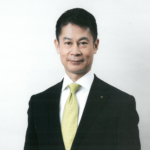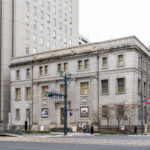Timeline of the Events Related to Hiroshima’s Reconstruction
| 1589 | Construction of Hiroshima Castle was started by order of Terumoto Mori |
| 1871 | Hiroshima Prefecture was established, in the course of abolishment of the feudal domain system and the setting up of a prefecture system |
| 1888 | The 5th Division Headquarters of the Imperial Japanese Army was established in Hiroshima |
| 1889 | A new system of municipalities was enforced and Hiroshima officially became one of the first cities in Japan ( April) Construction of Ujina Port was completed (November) |
| 1894 | The Sanyo Railroad reached Hiroshima (June) The First Sino-Japanese war was broke out (August). The Imperial Headquarters were moved to Hiroshima in response to the war (September) The Provisional Imperial Diet was held in Hiroshima (October) |
| 1902 | Hiroshima Higher Normal School was established (April) |
| 1912 | Hiroshima Denki Kido Company (current Hiroshima Electric Railway) started service (November) |
| 1915 | Hiroshima Prefectural Commercial Exhibition Hall (current the A-bomb Dome) was opened (August) |
| 1929 | Hiroshima’s first department store, “Fukuya” opened (October) |
| 1945 | The Second General Army, which commanded troops in western Japan, was established in preparation for decisive battles on the mainland and its headquarters were located in Hiroshima (April) An atomic bomb was dropped on the city of Hiroshima (August 6, 8:15 a.m.) An atomic bomb was dropped on the city of Nagasaki (August 9, 11:02 a.m.) The Japanese government accepted the Potsdam Declaration (August 14, on the next day, August 15, the Showa Emperor’s imperial edict ending the war was radiobroadcasted) |
| 1946 | Hiroshima Reconstruction City Planning was determined |
| 1947 | The Constitution of Japan was enforced (May 3) The 1st Peace Festival was held in Hiroshima City (August 6) |
| 1949 | Hiroshima Peace Memorial City Construction Law was enacted (in May, enforced on August 6) |
| 1951 | San Francisco Peace Treaty was signed (in September. came into force on April 28, 1952) |
| 1952 | Hiroshima Peace Memorial City Construction Planning was determined |
| 1955 | The 1st World Conference against A and H Bombs was held in Hiroshima City (August 6) Hiroshima Peace Memorial Museum was opened (August 24) |
| 1956 | Hiroshima Atomic-bomb Hospital (current Hiroshoima Red Cross Hospital & Atomic-bomb Survivors Hospital) was opened (September) |
| 1957 | Atomic Bomb Survivors Medical Care Law was enforced (April) |
| 1958 | Hiroshima Reconstruction Exposition was held (from April 1 through May 20) The Children’s Peace Monument was unveiled (May 5) |
| 1966 | The Hiroshima City Council unanimously passed a resolution to permanently preserve the A-bomb Dome (July) |
| 1968 | Atomic Bomb Survivors Special Measures Law was enforced (September) |
| 1969 |
The Moto-machi district was designated as an residential area for improvement (March) |
| 1970 | The first nursing home for A-bomb survivors in Japan, Funairi Mutsumi-en opened |
| 1975 | Sanyo Shinkansen reached Hiroshima Station (March) Professional baseball team, Hiroshima Toyo CARP marked its first leaguechampionship (October) |
| 1976 | Mayors of Hiroshima and Nagasaki visited the United Nations Headquarters and requested the abolition of nuclear weapons (December) |
| 1978 | The Moto-machi district redevelopment project was completed (commemorative ceremony was held in October) |
| 1980 | Hiroshima became Japan’s tenth “government ordinance designated city” (April) |
| 1982 | The World Conference of Mayors for Peace through Inter-city Solidarity (current Mayors for Peace) was established in response to the proposal by mayors of Hiroshima and Nagasaki (June) |
| 1985 | General Conference of the 1st World Conference of Mayors for Peace through Intercity Solidarity held in Hiroshima (August), to be held once in four years |
| 1992 | The 1st United Nations Conference on Disarmament Issues was held in Hiroshima (June. also held in 1994, 1996, 2015 and 2017) |
| 1994 | The East Building of Hiroshima Peace Memorial Museum was opened (June) The 12th Asian Games Hiroshima 1994 was held (October) |
| 1995 | Atomic Bomb Survivors Support Law was enforced (July) In response to a UN resolution, the International Court of Justice heard oral statements regarding the illegality of the use of nuclear weapons. The mayors of Hiroshima and Nagasaki gave their presentations at the Court. |
| 1996 | The A-bomb Dome and Miyajima (Itsukushima Shinto Shrine) were registered on the list of the world heritage sites (December) |
| 1997 | The Japan International Cooperation Agency (JICA) Chugoku International Center opened (April) |
| 2001 | Hiroshima’s first underground shopping mall, Kamiyacho Shareo opened (April) |
| 2002 | The Hiroshima National Peace Memorial Hall for the Atomic Bomb Victims opened (August) |
| 2003 | United Nations Institute for Training and Research (UNITAR) Hiroshima Office opened (July) |
| 2009 | The new Hiroshima Municipal Baseball Stadium, “Mazda Zoom-Zoom Stadium Hiroshima” was completed (March) |
| 2010 | The World Summit of Nobel Peace Laureates was held in Hiroshima (November) |
| 2014 | The Ministerial Meeting of the Non-Proliferation and Disarmament Initiative (NPDI) was held in Hiroshima, and “Hiroshima Declaration“ was adopted (April) |
| 2016 | G7 Hiroshima Foreign Ministers’ Meeting was held in Hiroshima (April) President Obama of the United States visited Hiroshima (May) |
| 2017 | Treaty on the Prohibition of Nuclear Weapons was adopted at the United Nations Headquarters in New York (July) |
Inquiries about this page
Hiroshima Prefectural Office
Street address:10-52, Motomachi, Naka-ku, Hiroshima-shi, Hiroshima-ken, 730-8511
Tel:+81-(0)82-228-2111





-150x150.jpg)


